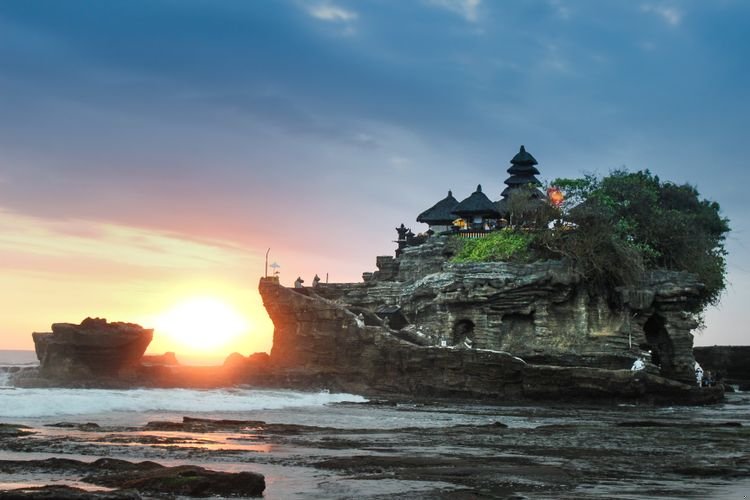Perched dramatically on the edge of rugged cliffs, Uluwatu Temple, or Pura Luhur Uluwatu, stands as one of Bali’s most iconic landmarks. This stunning temple offers breathtaking ocean views and a rich cultural experience, embodying the island’s spiritual heritage. Many visitors flock here to witness its majestic sunsets and traditional Kecak dance performances.
Nestled in the heart of Bali’s scenic coastline, the nama pura terkenal di bali yang dibangun pada ujung batu karang serves as a perfect complement to the island’s rich tapestry of culture and natural beauty. As you explore Uluwatu, the blend of history, breathtaking scenery, and spirituality invites you into a world where the land meets the divine.
Nama Pura Terkenal di Bali yang Dibangun pada Ujung Batu Karang
Bali, the Island of the Gods, is renowned for its stunning landscapes, rich culture, and spiritual heritage. One of the most captivating features of this paradise is its iconic temples, known as ‘pura’. Among these sacred sites, several temples are uniquely perched on the edge of cliffs and rocky outcrops, creating breathtaking views and an air of mysticism. In this detailed exploration, we will delve into the most famous ‘pura’ built on the edges of rocky cliffs, highlighting their history, significance, and the experiences they offer to visitors.
Pura Tanah Lot
Pura Tanah Lot is perhaps the most famous sea temple in Bali. Located on a rocky islet off the coast of Tabanan, it is a stunning example of Balinese architecture and spirituality. The temple’s name means ‘Land in the Sea’, which perfectly describes its position.
History and Significance
Pura Tanah Lot dates back to the 15th century and was established by the revered Hindu priest Nirartha. According to legend, he saw the rock as a perfect place for a temple dedicated to the sea god, Bhatara Baruna. Over the centuries, this temple has become a symbol of Bali’s cultural heritage.
- Spiritual Role: Tanah Lot serves as a place of worship for Balinese Hindus, especially for rituals related to the sea.
- Cultural Impact: The temple attracts thousands of visitors each year, making it an essential part of Bali’s tourism industry.
- Mythical Stories: Local folklore surrounds the temple, including tales of sacred snakes that guard the temple from evil spirits.
Visiting Tanah Lot
Visiting Tanah Lot is an unforgettable experience, particularly during sunset when the sky transforms into a kaleidoscope of colors.
– **Best Time to Visit:** The ideal time is during the evening when tourists gather to witness the sunset.
– **Access:** Visitors can reach the temple via a pathway lined with souvenir shops and local snacks.
– **Dress Code:** Given its sacred status, respectful attire is required. Sarongs and sashes are available at the entrance.
Pura Uluwatu
Perched on a 70-meter high cliff in the southern part of Bali, Pura Uluwatu is not only a temple but also a famous cultural site for its Kecak dance performances.
History and Cultural Significance
Pura Uluwatu, believed to be built in the 10th century, is dedicated to the ‘Spirit of the Sea’. The temple plays a critical role in Balinese Hinduism as a place of protection from evil spirits.
– **Historical Importance:** This temple is one of the nine directional temples in Bali, which protect the island from evil forces.
– **Cultural Events:** The temple hosts the Kecak and Fire Dance performances, showcasing Balinese culture through dramatic storytelling.
Visiting Uluwatu
When you visit Pura Uluwatu, you will be amazed not only by its architectural beauty but also by the stunning ocean views.
– **Location:** Situated approximately 25 kilometers from Denpasar, the temple provides breathtaking views of the Indian Ocean.
– **Kecak Dance:** The performance starts at sunset, enhancing the experience with captivating storytelling and traditional music.
– **Wild Monkeys:** The surrounding area is home to playful monkeys, adding a lively element to your visit.
Pura Luhur Batukaru
Although slightly inland compared to the sea temples, Pura Luhur Batukaru deserves mention for its beautiful mountain setting and cultural significance.
Historical Background
Pura Luhur Batukaru is one of Bali’s six key temples. It is situated on the slopes of Mount Batukaru and is dedicated to the god who resides in the mountain, Mahadewa.
- Founding Legend: Built in the 11th century, it was established to provide protection and guidance to the local farmers in the region.
- Spiritual Place: The temple serves as a place where locals come to pray for blessings on their crops and harvests.
Experience at Pura Luhur Batukaru
Visiting Pura Luhur Batukaru is a serene experience away from the bustling tourist spots.
– **Scenic Location:** Nestled in lush rainforest, the temple offers a tranquil environment filled with the sounds of nature.
– **Cultural Events:** It’s important to note that local ceremonies and events are often held here, showcasing authentic Balinese traditions.
– **Nature Trails:** The surrounding area is ideal for hiking and exploring the natural beauty of Bali.
Pura Taman Ayun
Though not built on a cliff, Pura Taman Ayun deserves recognition as it features expansive gardens and traditional Balinese architecture.
Architectural Marvel
Pura Taman Ayun, constructed in the 17th century, is a royal temple of the Mengwi Empire. Known for its beautiful landscape and water features, the temple represents the harmony between nature and spirituality.
- Design: It boasts multi-tiered shrines called “meru,” which are unique to Balinese architecture.
- Gardens: The temple is surrounded by a lush moat and gardens, creating a peaceful atmosphere for reflection and prayer.
Visiting Taman Ayun
Visitors to Taman Ayun can enjoy both the temple’s beauty and its serene surroundings.
– **Access:** Located in Mengwi, it is easily accessible and less crowded compared to other temples.
– **Best Time to Visit:** Early morning or late afternoon offers a quieter atmosphere and better lighting for photography.
– **Cultural Activities:** Traditional ceremonies often happen in the temple, providing insights into Balinese culture.
Pura Sakenan
Located on Serangan Island, Pura Sakenan is another notable sea temple. It holds spiritual significance for Balinese Hindus, particularly during the full moon.
Historical Context
Pura Sakenan dates back to the 16th century and is dedicated to deity Widi Sakti. This temple is known for its vibrant festivals and rituals.
- Full Moon Celebrations: The temple hosts grand celebrations during the full moon, drawing devotees from around the island.
- Historical Importance: Pura Sakenan is intertwined with the history of the Balinese Hindu community, offering a glimpse into their spiritual practices.
Visiting Pura Sakenan
Pura Sakenan provides an opportunity to enjoy both spiritual and natural beauty.
– **Access:** A short boat ride to Serangan Island introduces visitors to the temple.
– **Scenic Views:** The temple offers stunning views of the ocean and the surrounding landscape.
– **Cultural Immersion:** Participate in local festivals to immerse yourself in Balinese traditions.
Preserving the Heritage of Bali’s Temples
Protecting these iconic temples is essential for maintaining Bali’s cultural integrity. Several initiatives focus on preserving and promoting sustainable tourism.
Conservation Efforts
The Balinese government, along with local communities, is actively engaged in preserving these sacred sites.
- Restoration Projects: Regular restoration is essential to combat weathering and maintain the temples’ structural integrity.
- Awareness Campaigns: Educating visitors about the cultural significance of rituals and practices helps foster respect.
- Sustainable Tourism Practices: Encouraging responsible tourism helps protect the temples while supporting the local economy.
Visitor Guidelines
When visiting temples in Bali, it’s crucial to respect local customs.
– **Dress Appropriately:** Wear a sarong and sash to show respect.
– **Follow Photography Rules:** Some areas may restrict photography to maintain the sanctity of the space.
– **Participate Respectfully:** If attending a ceremony, follow the lead of locals, and observe quietly.
Bali’s temples built on rocky outcrops are not just places of worship; they embody the island’s rich spiritual and cultural identity. Each temple tells a unique story, reflecting the beliefs and values of the Balinese people. When you visit these sites, you not only witness their stunning architecture but also experience the island’s living traditions.
As you explore Bali, make sure to take the time to visit these remarkable temples. They offer a glimpse into the island’s heart and soul, providing a unique connection to its vibrant culture and history. Enjoy the breathtaking views, participate in local ceremonies, and immerse yourself in the mystique of Bali’s spiritual heritage.
Ular Kepala Manusia di Papua
Frequently Asked Questions
“`html
What is the significance of the temple built on the cliff in Bali?
The temple built on the cliff in Bali holds deep cultural and spiritual significance for the local community. It serves as a place of worship and is dedicated to the sea gods, reflecting the Balinese Hindu belief system. Locals believe that this temple protects them from the ocean’s dangers and offers blessings for safe voyages and abundant harvests.
How can visitors access the temple located at the edge of the cliff?
Visitors can access the temple by following designated paths that lead from nearby parking areas. Many tourist agencies offer guided tours that include transportation and informative commentary. It’s important for visitors to wear appropriate attire, as temples in Bali require modest clothing to show respect for the sacred sites.
What unique features does the temple on the cliff have?
This temple features striking architecture that harmonizes with its natural surroundings. Visitors will notice intricate carvings, decorative statues, and stunning views of the ocean. The temple’s location also provides breathtaking sunset views, making it a popular spot for photography.
Are there any cultural events or rituals held at the temple?
Yes, the temple hosts various cultural events and rituals throughout the year, especially during important Balinese Hindu celebrations. These events often include traditional music, dance performances, and offerings to the gods, attracting both locals and tourists eager to experience Balinese culture.
What precautions should visitors take when visiting the cliffside temple?
Visitors should be cautious of the steep cliffs and rocky paths when exploring the area around the temple. It’s advisable to wear sturdy footwear and stay within designated walkways to ensure safety. Additionally, visitors should respect the religious customs and be mindful of the local community while visiting the site.
“`
Final Thoughts
The iconic ‘nama pura terkenal di bali yang dibangun pada ujung batu karang’ captivates visitors with its breathtaking views and spiritual significance. This remarkable temple stands as a testament to Bali’s rich cultural heritage and deep-rooted traditions. Visitors often find themselves enchanted by its serene atmosphere and stunning surroundings. A visit to this temple offers an unforgettable experience that highlights the beauty and spirituality of Bali.






